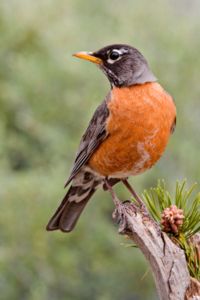American Robin
Conservation status Least concern |

|
|
Scientific classification |
| Kingdom: |
Animalia
|
| Phylum: |
Chordata
|
| Class: |
Aves
|
| Order: |
Passeriformes
|
| Family: |
Turdidae
|
| Genus: |
Turdus
|
| Species: |
T. migratorius
|
|
|
Binomial name |
Turdus migratorius
Linnaeus,
1766 |
The American Robin (Turdus migratorius) is
a
migratory
songbird of the
thrush family.
Overview
The American Robin is 25–28 cm (10–11 in) long. It has
gray upperparts and head, and orange underparts, usually
brighter in the male; the similarity between this coloring
and that of the smaller and unrelated
European Robin (Erithacus rubecula) led to its
common name. There are seven races, but only T. m.
confinus in the southwest is particularly distinctive,
with pale gray-brown underparts.
During the breeding season, the adult males grow
distinctive black
feathers on their heads; after the breeding season they
lose this eye-catching plumage.
This bird breeds throughout Canada and the United States.
While Robins occasionally overwinter in the northern part of
the United States and southern Canada, most winter in the
southern parts of the breeding range and beyond, from the
southern U.S.A. to Guatemala. Most depart south by the end of August and
begin to return north in February and March. (Exact dates
vary with latitude and climate, of course.)
This species is a very rare vagrant to western Europe. In
autumn 2003, migration was displaced eastwards leading to
massive movements through the eastern USA. Presumably this
is what led to no fewer than three American Robins being
found in Great Britain, with two attempting to overwinter in
2003–4, one eventually being taken by a Sparrowhawk.
As with many migratory birds, the males return to the
summer breeding grounds before the females and compete with
each other for nesting sites. The females then select mates
based on the males' songs, plumage, and territory quality.
The females build the nest and lay three or four blue
eggs in the lined cup. Incubation, almost entirely by
the female is 11-14 days to hatching, with another 15–16
days to fledging. Two broods in a season are common. The
adult male looks after the fledged chicks while female
incubates her second clutch. Some people enjoy the Robin's
presence, and want to protect the chicks; they do this by
building nesting shelves for the Robin's use. Bird banders
found that only 25% of young robins survive the first year.
The American Robin's habitat is all sorts of woodland and
more open farmland and urban areas. Food is the typical
thrush mixture consisting largely of insects and earthworms.
Robins are also fond of some berries, including those of the black cherry tree; they
will fly in especially to feed on them during the period
when they ripen.
Robins are frequently seen running across lawns, picking
up earthworms by sight. In fact, the running and stopping
behavior is a distinguishing characteristic. When stopping,
they are believed to be listening for the movement of prey.
Without showing symptoms, the American Robin is sometimes
a carrier of the
West Nile virus in the Western hemisphere.
This is the state bird of
Connecticut, Michigan, and Wisconsin.
Song and calls
The American Robin, like many thrushes, has a beautiful
and complex song, and in contrast to other thrushes, its
song is almost continuous. Its song is commonly described as
a cheerily carol song. The song is made of discrete
units, often repeated, and spliced together into a string
with brief pauses in between. The song varies regionally,
and its style varies by time of day. American Robins will
often be among the last songbirds singing as the evening
sets in.
In addition to its song, the American Robin has a number
of calls used for communicating specific information. When a
ground predator approaches but does not directly threaten,
Robins will make a PEEK!! tut tut tut tut... warning
call. When a nest or Robin is being directly threatened,
another call is used, which sounds like a horse's whinny.
Even during nesting season, when Robins exhibit mostly
competitive and territorial behaviour, they may still band
together to drive away a predator. Robins also make a very
high-pitched sound when a hawk or other bird of prey is
seen; other robins will repeat the sound, seek cover, and
stop moving. During the colder parts of the year, the
American Robin gathers in flocks around food sources, and
there is yet another call that is heard in such flocks.
Trivia
- Crayola has a crayon color,
robin's egg blue named after the color of the eggs.
- The American Robin was depicted on the 1986 series
Canadian $2 note.
- The
Disney film Mary Poppins, set in London, incorrectly
portrayed American Robins singing by an open window,
despite the fact that the European Robin is the only
bird named as a robin to be commonly found in the United
Kingdom. Additionally, both robins building
the nest in that film are males.
Photo gallery
|
|
|
Nest, approximately 5 inches (13 cm)
across,with four eggs
|
Same nest with four chicks. The pink "runt"
in the center hatched two days later than
its nest mates
|
|
|
References
- BirdLife International (2004).
Turdus migratorius. 2006
IUCN Red List of Threatened Species.
IUCN 2006. Retrieved on 12 May 2006. Database entry
includes justification for why this species is of least
concern
- Thrushes by Clement and Hathaway,
ISBN 0-7136-3940-7
-
Design for human-built nesting shelves
External links




